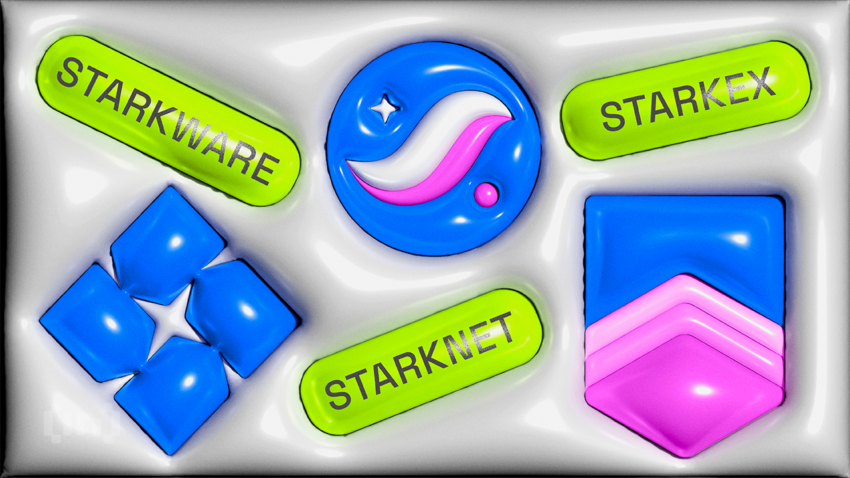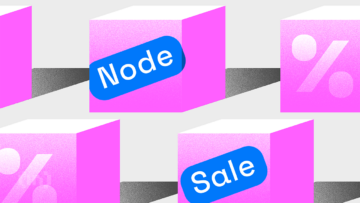Ethereum is one of the key pioneers of the crypto industry, spearheading the evolution of decentralized finance (DeFi), play-to-earn gaming, and other blockchain-based applications. However, like many other blockchains, the Ethereum network faces scalability issues. StarkWare Industries is one of the companies creating innovative scaling solutions for blockchains, attempting to address these scaling challenges. This guide will teach you about Starkware, StarkNet, and StarkEx. Here’s how each of these scaling solutions works.
What is StarkWare?
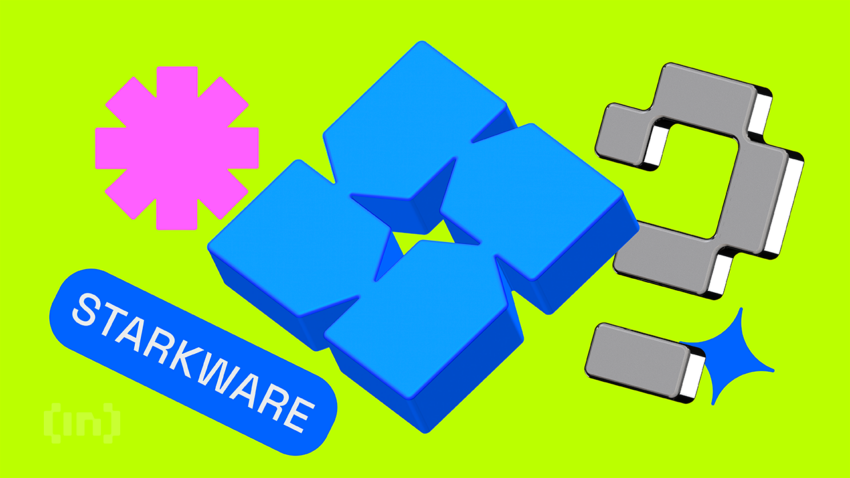
StarkWare Industries is an Israel-based software company specializing in cryptographic Proof systems that address scalability issues on the Ethereum network.
The company develops Zero-Knowledge Proof using proprietary STARK technology for computational security. StarkWare uses ZK-STARK (Zero-Knowledge Scalable Transparent Arguments of Knowledge) technology to improve blockchains’ scalability, transparency, privacy, and security to create a seamless user experience.
The company is among several projects in the layer-2 ecosystem that have created scaling solutions, including Polygon, Loopring, Arbitrum, and Cartesi.
History of StarkWare
StarkWare Industries was founded in 2018 in Netanya, Israel. The founding members are Uri Kolodny, Eli Ben-Sasson, Michael Riabzev, and Alessandro Chiesa, a team with diverse expertise and backgrounds. The company’s mission is to solve scalability challenges and improve privacy and efficiency for blockchain networks.
StarkWare developed its first proprietary scaling engine, StarkEx, in June 2020 and, in November 2021, launched StarkNet on the Ethereum mainnet. All StarkWare products use Cairo as their programming language. StarkWare aims to go beyond the solutions offered by Ethereum EIPs when addressing Ethereum’s inherent scalability problems, thus developing its own technological scaling solutions.
Cairo
Cairo is a Turing-complete programming language invented by StarkWare. It’s a developer-friendly language, the native smart contract language for StarkNet. StarkWare aims to make Cairo a Rust-like language that is easy to read and write smart contracts to encourage faster code development, review, and maintenance.

Cairo is suited for permissionless networks because it has an intermediate representation (Sierra) that ensures every Cairo program and its input can be proven.
ZK-STARK Proof
StarkWare invented ZK-STARK, a Proof that uses cryptography for polylogarithmic verification to enforce the integrity and privacy of computation on a blockchain. ZK-STARK is a transparent Proof system that allows blockchains to move large computations off-chain to a single STARK prover. Then, the integrity of the computations is verified using an on-chain STARK verifier. The verification requires a fraction of the computation, so processing a batch of transactions off-chain reduces the load on the mainnet, lowering trading fees.
“We urgently need to reduce the burden we’re inflicting per transaction on blockchain nodes in order to make crypto mainstream.”
Eli Ben-Sasson, Co-founder of StarkWare
What is StarkNet?

StarkNet is a permissionless and decentralized Validity-Rollup (ZK-Rollup) operating as a layer-two network on Ethereum.
StarkWare developed StarkNet to enable decentralized applications (DApps) to achieve unlimited computation scales without compromising Ethereum’s security and composability. The ZK-Rollup relies on STARK Proof to provide a scalable environment for developers to build and deploy DApps on the Ethereum mainnet.
Developers can write in any Ethereum Virtual Machine (EVM)-compatible language on StarkNet using zkEVM, a ZK-rollup that mimics aspects of Ethereum’s design. They can leverage Cairo to deploy any business logic on the network.
How does StarkNet work?
StarkNet improves blockchain scalability by having sequencers select transactions and execute the calculations off-chain. Then, a ZK-STARK Proof is generated for the transactions to validate them on the Ethereum mainnet in batches.
StarkNet increases throughput and transaction speeds, helping Ethereum increase its transaction capacity and save on gas costs. The account contracts on StarkNet, inspired by Ethereum EIP-4337, must include two functions: validate and execute. These functions ensure that only you can initiate transactions and pay fees for the resources you use.
StarkNet vs. Arbitrum
While StarkNet and Arbitrum are layer-2 scaling solutions on Ethereum, the technology of each differs. StarkNet is a ZK-Rollup that assumes all transactions are false until proven valid. On the other hand, Arbitrum uses optimistic rollups that assume all transactions are valid until proven otherwise by a network validator.
Optimistic rollups use fraud-proof mechanisms to ensure transaction validity using honest validators to secure the network. ZK-Rollups use sophisticated cryptography to validate transactions. Moreover, Arbitrum is EVM-compatible, whereas StarkNet uses a custom Cairo VM.
StarkGate bridge
StarkGate is the StarkNet native bridge that enables you to bridge ERC-20 tokens between Ethereum and StarkNet. The bridge conducts transactions through the StarkNet Alpha network and the STARK-based computational compression capabilities.
It allows you to bridge supported tokens from Ethereum, Polygon, Optimism, Arbitrum, and other networks. StarkGate supports the transfer of assets, including USDC, DAI, USDT, and WBTC, directly to StarkNet.
StarkNet token
StarkNet has a native token, STRK, which launched in July 2022. STRK is an ERC-20 token built on Ethereum. It is used to maintain and secure the StarkNet network. The token also has governance functions, such as voting on blockchain decisions, and is used for transactions on the network.
What is StarkEx?
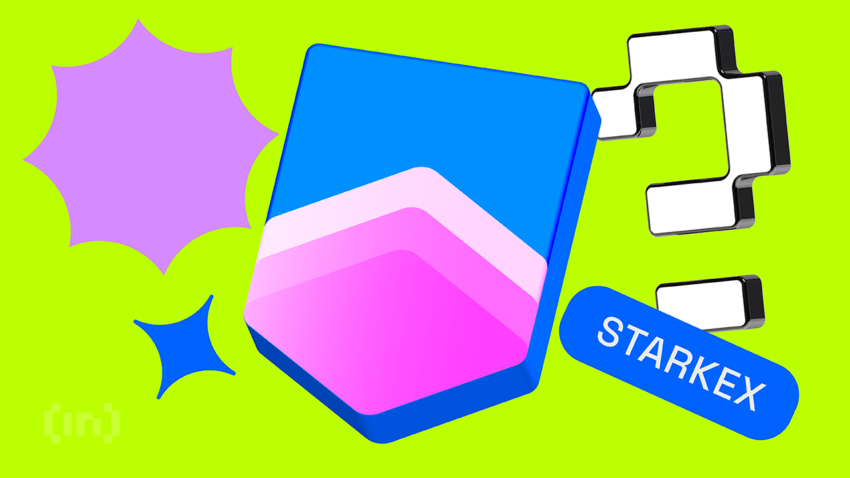
StarkEx is a layer-2 scaling solution on the Ethereum mainnet powered by STARK. It provides a framework for creating scalable, self-custodial application-specific solutions, particularly for trading applications.
Some DeFi applications deployed on StarkEx include:
- dYdX (perpetual trading)
- Rhino.fi (spot trading)
- Immutable (NFT minting and trading)
- Reddio (NFT minting and trading)
- Canvas (finance)
StarkEx uses ZK-STARK to execute computations off-chain to improve transaction speeds and reduce trading fees for decentralized exchanges (DEXs). It can support many assets, including tokens on other EVM-compatible blockchains, ETH, synthetic assets, ERC-20, ERC-721, and ERC-1155.
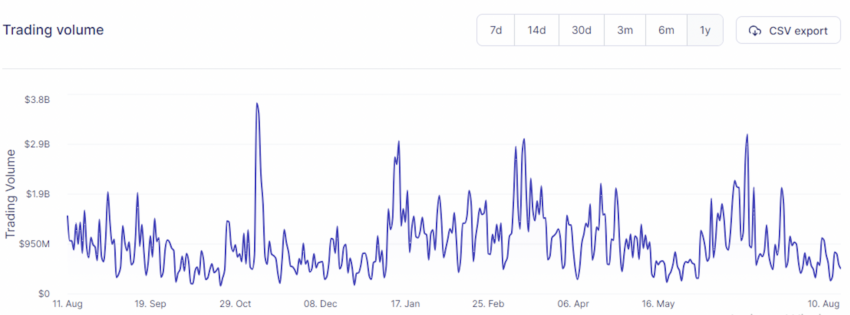
StarkEx trading volumes have oscillated between $500 million and $2 billion since August 2022, with a few outlier weeks.
How does StarkEx work?
StarkEx has a hybrid architecture with off-chain and on-chain components utilized in three data availability modes: ZK-Rollup, Validium, and Volition.
The off-chain component is in charge of holding the state of order, executing transactions in the system, and sending updates to the on-chain components. The on-chain component is responsible for enforcing the validity of state transition, holding state commitments and system assets, and managing on-chain accounts.
Let’s look at how transactions are executed and verified on StarkEx.
- The user generates a transaction with the application, which reviews all transactions, including trades, transfers, and cancellations, and sends them to the StarkEx Service.

- The StarkEx Service batches transactions and sends them to the Shared Prover Service, SHARP, to generate Proof for the computational validity of the batch.
Did you know? A Shared Prover is called ‘SHARP’ because nearly all StarkEx operators send their transaction to “share” the proof that the Stark Prover generates.
- SHARP represents all the batched transactions in a Proof, then sends it to the on-chain STARK Verifier smart contract, which checks that the transactions in the batch are authorized and valid.
- Once the Proof is verified, the StarkEx Contract accepts an on-chain state update transaction sent by the StarkEx Service.
Users interact with the system by sending off-chain transactions to the applications and on-chain transactions to the StarkEx Contract.
The StarkWare potential
StarkWare products, Cairo, StarkEx, and StarkNet, are promising solutions to address blockchains’ scalability problems. Its ecosystem is building rapidly with new knowledge tools that are revolutionizing the DeFi space. The company’s off-chain and on-chain components ensure you get some of the lowest Ethereum gas fees with improved privacy and security.
Frequently asked questions
What is StarkEx?
What is StarkNet crypto?
Is StarkEx a blockchain?
What is the difference between Starknet and StarkEx?
How much is StarkNet coin worth?
Is StarkWare a layer-2?
Is StarkNet a layer-2?
Is StarkNet EVM compatible?
Disclaimer
In line with the Trust Project guidelines, the educational content on this website is offered in good faith and for general information purposes only. BeInCrypto prioritizes providing high-quality information, taking the time to research and create informative content for readers. While partners may reward the company with commissions for placements in articles, these commissions do not influence the unbiased, honest, and helpful content creation process. Any action taken by the reader based on this information is strictly at their own risk. Please note that our Terms and Conditions, Privacy Policy, and Disclaimers have been updated.


